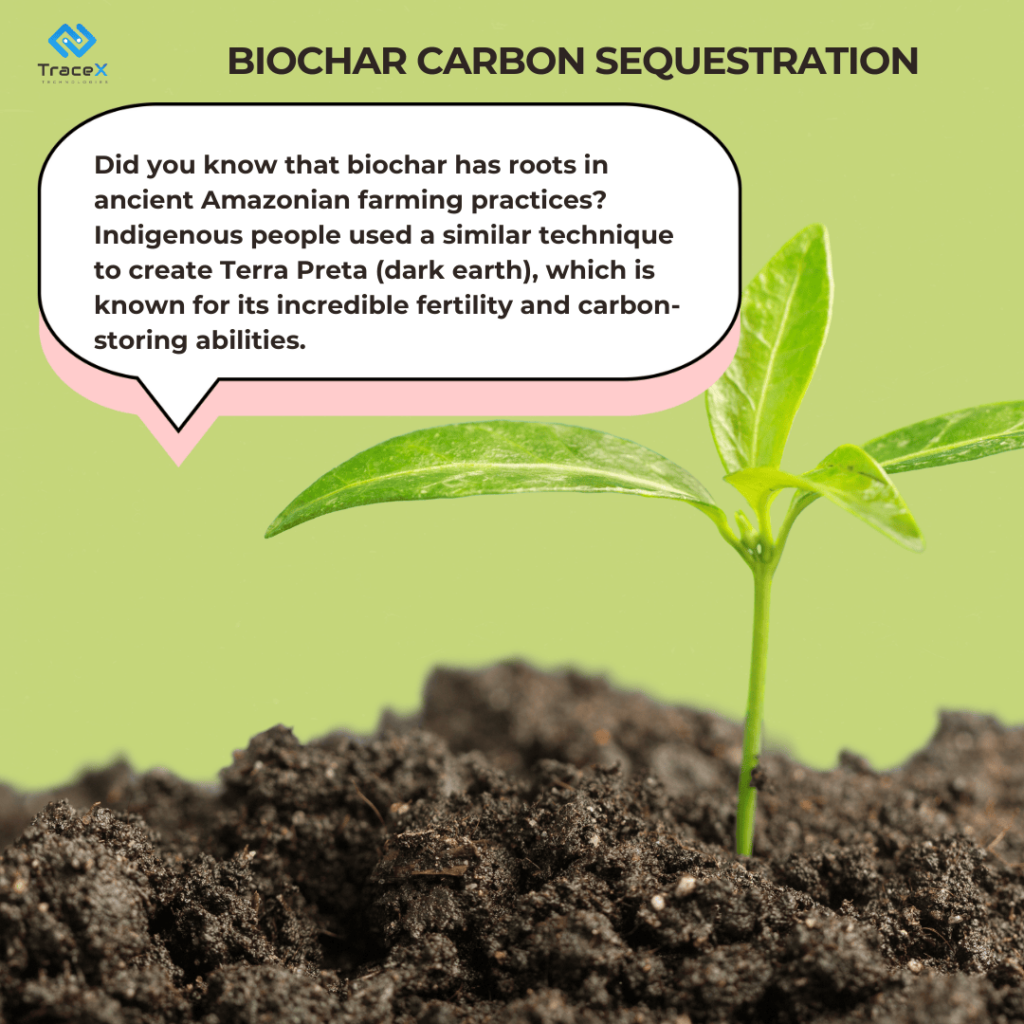Contact: +91 99725 24322 |
Menu
Menu
Quick summary: Discover how biochar helps in carbon sequestration and why it’s considered a sustainable climate solution. Learn about its role in reducing greenhouse gases, improving soil health, and contributing to global carbon reduction efforts.

Biochar has become a buzzword in sustainable agriculture and climate action, but what exactly is it, and how can it help in the battle against climate change? Biochar is a form of carbon-rich charcoal that, when added to soil, enhances its health while serving as a stable storage medium for carbon. This process, known as biochar carbon sequestration, plays a critical role in reducing atmospheric CO₂ levels.
According to Science Direct, thanks to its aromatic properties, biochar can remain in the environment for a long time while absorbing greenhouse gases (GHG). Annually, biochar is estimated to sequester between 1 and 35 gigatons (GtCO2) of CO2 and between 78 and 477 GtCO2 over the course of this century.
As industries struggle with reducing emissions, finding effective methods for long-term carbon storage becomes increasingly difficult. This is where biochar steps in, offering a sustainable, nature-based solution that benefits both the environment and agricultural productivity. Let’s explore how this innovative approach can make a real difference in tackling climate change.
Key Takeaways
Biochar is a carbon-rich material produced by heating organic matter, like agricultural waste or biomass, in a process called pyrolysis. Pyrolysis involves heating the biomass in the absence of oxygen, which prevents it from burning and instead transforms it into a stable form of carbon. The result is a black, charcoal-like substance that can be applied to soil.

When organic matter like plant residues or wood is turned into biochar, the carbon stored in that biomass is “locked” into a stable form. This prevents it from decomposing back into CO₂, which would typically occur if the biomass were left to decompose naturally.
Once added to the soil, biochar can remain stable for hundreds to thousands of years, effectively sequestering carbon that would otherwise contribute to greenhouse gas emissions. Its porous structure also improves soil health, further benefiting the environment.
The process of creating biochar can also be designed to capture and utilize gases released during pyrolysis, turning potential pollutants into energy sources. This aspect further reduces the carbon footprint of biochar production.
Let’s delve a little deeper into the science. During pyrolysis, the conversion of biomass into biochar retains approximately 50% of the carbon content of the original material. This conversion makes biochar much more stable than other forms of organic carbon like plant residues, which would otherwise decay and release carbon dioxide back into the atmosphere.
Why is this important? Well, it means that biochar has the potential to sequester a significant amount of carbon per ton of biomass used, making it a highly effective tool in carbon management strategies. For comparison, other carbon sequestration methods like reforestation can take decades to stabilize carbon levels, whereas biochar offers immediate and long-term benefits.
1. Long-term Carbon Storage: Unlike other organic materials, which can break down over time, biochar remains stable in the soil, acting as a carbon storage facility for centuries.
2. Improves Soil Health: Biochar’s porous structure makes it a great habitat for beneficial soil microbes, promoting nutrient retention and water-holding capacity. This, in turn, boosts plant growth and reduces the need for chemical fertilizers.
3. Reduces Methane and Nitrous Oxide Emissions: Biochar can reduce emissions of other potent greenhouse gases like methane (CH₄) and nitrous oxide (N₂O) from soils, making it a holistic approach to tackling climate change.
4. Supports Circular Economy: Biochar production can utilize agricultural residues, forestry by-products, and other organic wastes that would otherwise contribute to landfill emissions. This supports a circular economy, reducing waste and turning it into a valuable soil amendment.
The production of biochar might sound complex, but it boils down to a few key steps:
In Brazil, biochar has been applied to degraded lands to improve soil fertility while sequestering carbon. Farmers have reported improved crop yields and soil structure, along with reduced fertilizer needs. The practice also complements Brazil’s reforestation efforts, creating a multi-pronged approach to climate action.
Numerous deforested areas in Brazil are utilized for low-yield cattle ranching. As the second-largest meat producer globally, Brazil is expected to boost its agricultural production more than any other nation. Incorporating biochar into degraded soils has demonstrated enhancements in soil quality and agricultural yield, although the outcomes vary based on specific contexts.[ Source: Nature]
In North America, forest management agencies have been exploring biochar as a way to manage forest waste and reduce wildfire risks. By converting forest residues into biochar, they not only reduce the risk of forest fires but also create a valuable product that aids in carbon sequestration.[Source: Climatehub]
In Africa, biochar has been used to restore the fertility of severely degraded soils. Smallholder farmers have found that biochar improves crop yields and helps retain moisture during droughts, offering a sustainable way to improve food security and carbon management.[ Source: ScienceDirect]
Biochar isn’t just a tool for farmers and land managers—it also has a place in the world of carbon credits and carbon markets. By producing and applying biochar, businesses can generate carbon credits, which can be sold to organizations seeking to offset their emissions. This creates a financial incentive for adopting biochar as a part of sustainable practices.
Carbon credits from biochar can be part of a company’s strategy to achieve net-zero emissions, helping them meet regulatory requirements or fulfill corporate sustainability goals. With the increasing global emphasis on carbon neutrality, biochar is gaining attention as a viable solution in voluntary carbon markets.
DMRV solutions can automate the collection of critical data such as biomass input, production conditions, and application rates of biochar. By using IoT sensors and satellite monitoring, they provide real-time tracking of carbon flows throughout the biochar lifecycle, reducing manual data entry errors.
DMRV platforms can integrate recognized carbon accounting methodologies, making it easier for project developers to adhere to specific registry requirements. This ensures consistency and transparency in how data is recorded and reported, facilitating a smoother pathway to verification.
With advanced remote sensing capabilities, DMRV tools can track biochar application across large areas, monitor changes in soil carbon levels, and validate that the carbon remains sequestered. This reduces the need for costly on-site audits, making the verification process more affordable and efficient.
DMRV solutions enable transparent data sharing with stakeholders, including buyers of carbon credits, registries, and auditors. The ability to generate detailed reports from reliable data sources increases trust in the carbon credits issued and assures buyers of their authenticity.
Using machine learning and historical data, DMRV tools can provide insights into the long-term stability of biochar in different environmental conditions. This helps project developers and auditors estimate the expected duration of carbon storage, enhancing the credibility of the issued credits.
By addressing these challenges with DMRV tools, biochar projects can streamline the process of quantifying and validating carbon credits, making it easier to participate in voluntary carbon markets. This improves transparency, reduces costs, and ensures that the carbon credits generated are both credible and effective in driving climate action.
The TraceX DMRV (Digital Monitoring, Reporting, and Verification) platform offers a comprehensive solution for managing biochar projects by ensuring accurate carbon credit quantification and streamlined compliance.
The potential of biochar goes beyond just carbon sequestration. It offers a way to improve soil health, enhance food security, and create economic opportunities in rural communities. As more research is conducted and awareness grows, we can expect biochar to play a larger role in climate-smart agriculture and global carbon management efforts.
With international organizations like the United Nations promoting biochar as part of the solution to climate change, its future looks promising. Governments and NGOs are increasingly providing support for biochar projects, making it an exciting time for those looking to invest in this innovative solution.
In a world where climate change is one of the most pressing issues, biochar stands out as a simple yet powerful solution. By turning organic waste into a stable carbon sink, it offers a win-win scenario for both the environment and agricultural productivity. While challenges remain, the potential of biochar to transform farming practices and combat climate change is undeniable.
Whether you’re a farmer, a business leader, or a sustainability advocate, now is the time to explore how biochar can fit into your carbon management strategy and why quantification tools matter! By adopting biochar, you’re not just improving soil health—you’re also contributing to a more sustainable future for our planet.
Biochar is a carbon-rich material produced from organic waste through pyrolysis. It helps in carbon sequestration by storing carbon in a stable form in the soil, preventing it from being released as CO2 into the atmosphere.
Biochar enhances soil health by improving water retention, nutrient availability, and microbial activity. As it enriches the soil, it also traps carbon for hundreds to thousands of years, contributing to long-term carbon storage.
Biochar offers a sustainable way to reduce greenhouse gas emissions, as it sequesters carbon and reduces methane and nitrous oxide emissions from soil. Its use in agriculture also supports regenerative practices, making it a key tool in the fight against climate change.
